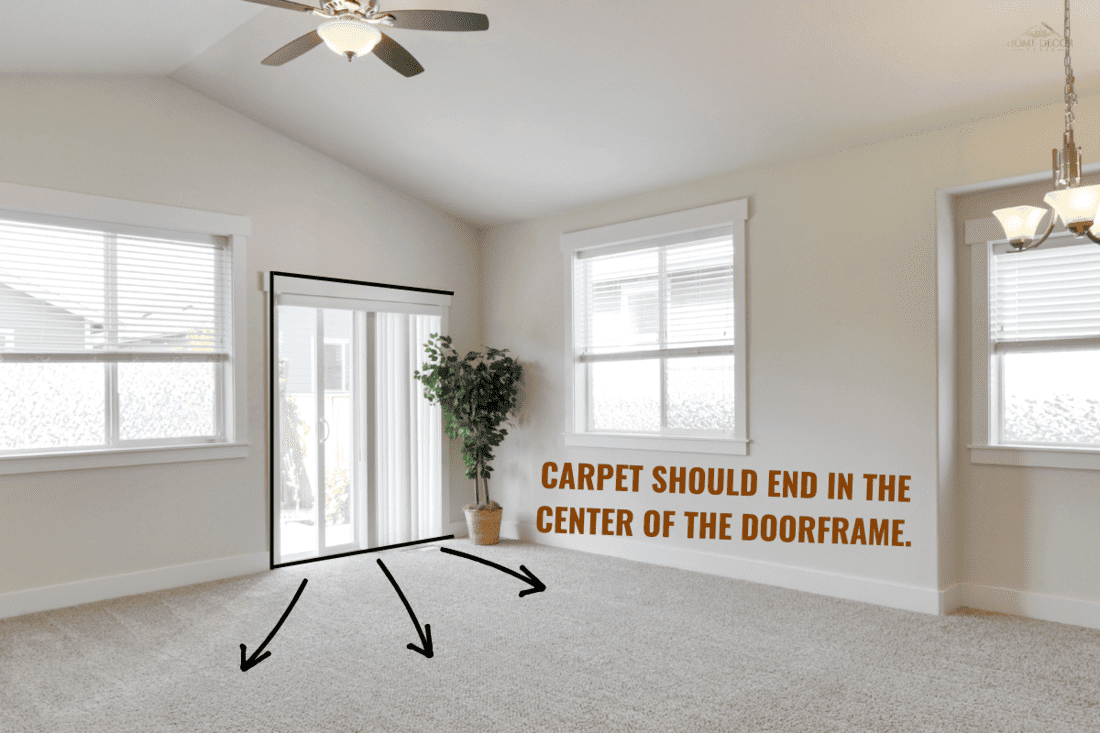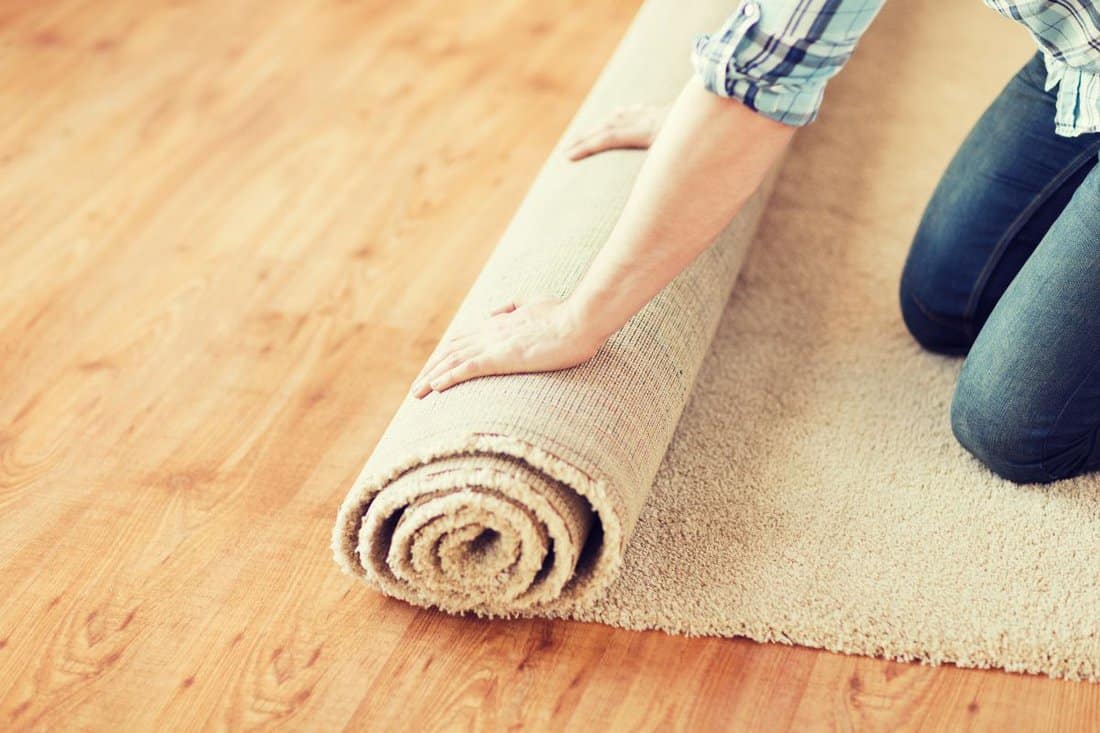Once you've picked out the flooring for your home, now you need to know exactly where each floor will be installed. You'll also need to know how much it will take to cover the floor. If you're wondering where, exactly, the carpet ends, flooring experts all agree on one easy answer.
Carpet should end in the center of the doorframe. This way, when the door is closed, the seam between different floors is not visible. The goal is only to see one flooring, regardless of whether you are inside or outside the room. The transition space should only be visible when the door opens.
Keep reading for more information and learn everything you need to lay carpet. This article will help with the tools and equipment that you'll need, how you can secure the carpet, when to use transition strips, and more!

Where Do You Cut Carpet In A Doorway?
We sometimes add affiliate links and content that was curated and created by our team with the help of advanced ai tools to help showcase the best design styles.

To properly install the carpet, you'll want to start with about two inches of extra carpet in the doorway. Then, use a chalk line or another measuring tool to draw a straight line in the doorway center. Cut the carpet, then use a seam sealer to keep the carpet from fraying.
Click here to see carpet seam sealer on Amazon.
At this point, it's best to install the carpet with a transition strip. If you are not using transition strips, you will instead use adhesive or staples to securely hold the carpet.
Do You Need Transition Strips Between Rooms?
Switching between different kinds of flooring typically also means switching between different heights and thickness of floorings. This can, potentially, be a tripping hazard. Transition strips actually are used primarily for this reason - to bring floors of varying heights together seamlessly. Transition strips also reduce wear to the carpet's edge, a minor (but still useful) reason to install them.
For this reason, you should almost always use transition strips between rooms. It doesn't just look better, it's safer. If you are using one kind of flooring, you may not need to use transition strips. Just be certain that the height (and the floor underlayment) really is consistent throughout.
Kinds of Transition Strips

Transition strips are made from a variety of materials. Modern strips are made to match just about any existing flooring out there. They come in hardwood and laminate styles, as well as PVC and the more traditional aluminum. Contractors sometimes even use material leftover from a floor installation to create custom transition strips.
There is also a variety of styles to suit every type of flooring and flooring combination. In this article, only strips used with carpeting are covered. This is, by no means, an exhaustive list.
T molding
T molding has a metal piece that lays underneath the carpet. It grips the carpet into place, while the visible "T" shaped portion connects carpeting to vinyl or wood. T molding works both in open rooms with multiple floorings and in doorways.
Click here to see t molding transition on Amazon.
Carpet Strip
Used to transition between carpet and another material of roughly the same height. This style is used in doorways.
Click here to see this transition strip on Amazon.
Tile to Carpet
Tile tends to be lower than most other surfaces, so you'll want to use a reducer such as this one. This evens out the difference between the carpet and the tile.
Click here to see this tile-carpet transition strip on Amazon.
Do You Put Carpet Tack Strips In A Doorway?

Carpet tack strips lay around the perimeter edges of the room. Strips do not go in the doorway. It is listed as a practice to be avoided in the Carpet and Rug Installer Standards.
If you're thinking, "I swear I saw someone else do it," you aren't crazy. Sometimes installers will use tack strips when the carpet ends in a doorway. But it's still incorrect, and the risk of someone stepping on a tack that pokes out of the carpet is real. Use one of the options for laying carpet without tack strips. Alternatively, use a transition strip to either cover over an already installed tack strip or to hold the carpet in place without tack strips in the doorway.
Can You Lay Carpet Without Tack Strips?
There are several options for laying carpet without tack strips. The simplest is to nail or staple the carpet down. However, some people do not like the chance of staples rusting or coming out.
There are adhesives available that glue the carpet down. This is a good solution for concrete, where most other installation methods won't work.
Click here to see carpet adhesive on Amazon.
Carpet seam tape is another option to install carpet, though it isn't always as effective as carpet glue. Carpet tape, glue, and tack strips can all be damaging to the subfloor, as well. See: "Does Carpet Tape Damage Wood Floors?"
Click here to see seam tape on Amazon.
In most cases, if you are trying to install an entire carpet without tack strips, staples or tacks are the best options. Carpet glue is the next choice. If you're simply trying to secure the carpet in a doorway, or patch a small area of new carpet, then the tape may be adequate.
Carpet Options Without Tack Strips
If you already know that you don't intend to use tack strips, the easiest answer may be to pick a carpet that doesn't need them. For example, there are carpet squares with adhesive already applied. These glue to the floor without having to use tack strips (or find a replacement).
Read more about carpet tile here: "Should Carpet Tiles Be Glued Down?"
Is Installing Carpet a DIY?

Carpet is typically one to leave for the professionals. It's not easy, and it takes a lot of special equipment. By the time you get the right items, you've usually spent more than just paying someone else to do it. Especially because frequently, buying new carpeting comes with free installation.
Even once you have the tools necessary to install carpet, it's not easy for a novice. Access to the equipment doesn't give you the experience needed to use them well. If you can't stretch the carpet properly, it may wrinkle or come loose. Using a carpet iron to seal seams can result in visible burns to the carpet. You may save a few bucks on installation, but you also may literally ruin a brand new carpet.
Experts understand how to lay the padding correctly to avoid bumps and wrinkles. They know how to follow manufacturers' directions in order not to void the carpet warranty. Professionals can cut the carpet correctly- even around heating and cooling registers, doorways, strange corners, and more. These are all skills that DIY installations typically struggle with, and the final result shows a lack of experience.
For more information, read: "Is Carpet Hard To Install? [Here's What Homeowners Need to Know]."
To Summarize
When installing carpet, it should end in the center of the doorway. This way, the transition from one floor to another remains hidden when the door is shut. The two kinds of flooring meet under the closed door, and only one floor is visible from any direction. It's also best to use transition strips in most cases when switching between floors. This looks neater and also reduces the chance of trips or falls between flooring of different heights.








Urgently need to remove and remove and replace dorway edge fixings Aluminium as attached
“Carpet is typically one to leave for the professionals. It’s not easy, and it takes a lot of special equipment.” A big thumbs up for this line. Since we are a carpet installation company, I’m sure that you’ll never regret it if you let the carpet pros do the work for you!